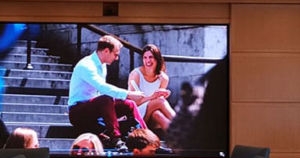If you are a company large enough to warrant having a boardroom – which is to say most – then you are a company large enough to warrant an impressive boardroom. To organizations of repute, regardless of size, the boardroom is where the most significant decisions are made. Many are used for less formal gatherings, too, but even in those cases, the quality of the decisions made in the boardroom has an important role in the prosperity of the organization. And with such weight resting on the quality of what comes out of the room, the quality of what goes into the room must be prioritized as well.
Things Change, Things Stay the Same
The typical boardroom looks different today than it did five, 10, or 25 years ago, but the space still requires the same few basic things. A table, obviously, around which to gather. Chairs, of course, in which to sit at said table. And thirdly, a platform with which to distribute visual data. There was once a case to be made that the table is the most important element of a distinguished boardroom. For a long time, it probably was, when regal hardwood or sleek futuristic angles impressed clients and made executives feel important. Fancy chairs helped there too. The reason the furniture in a boardroom was paramount in the past was not just to impress people but instead to create a strong decision-making environment. Surround people with comfort and style that reflects the company’s values and they will be more likely to reach decisions that also reflect those values (or so the thinking goes). That’s all well and good, but if digital integration is not part of the company’s values in 2020, I have some bad news.
Make no mistake, furniture still matters. It’s just that it matters less now than that third necessary element, the platform for the distribution of visual information. In prior years, that meant a simple projector or the same style of LCD television you might see in someone’s living room. That’s not good enough anymore. Crucial in creating a strong decision-making environment is not simply crafting the aesthetics but providing practical tools as well. Executives (and everyone else, too, realistically) are accustomed to having a monitor or three at their desk for analyzing data and communicating with others – why would you take these tools away in a boardroom setting, the place where presumably they need them most? Scott Walker, President and CEO of Waveguide, echoed this sentiment, saying, “How do you take the experience that an executive has at the desktop, which is seamless audio-video conferencing integration, and move that same experience through their personal conference room — through any space they may need, up to and including the boardroom?” The answer is not to take it away, the answer is to make it even bigger. The way to do that is with an LED video wall.
Dynamic, Versatile, Affordable
There is no edict that videowall technology in corporate environments belongs only in lobbies, control centers, or company museums, especially now that manufacturers are producing cabinet-based display lines with native 16:9 aspect ratios, like our newly redesigned Engage Series. As Cindy Davis wrote for AVIXA, “Boardrooms, which are often designed to impress their particular users and enhance decision-making, can also benefit from large visual canvases.” Platforms like these are large enough to display vast swaths of data, clear enough to interpret that data, and versatile enough to share that data with team members joining remotely. They’re affordable now, too, toppling an outdated hurdle that used to derail such grand pursuits.
If you are a decision-maker within your organization, the boardroom is likely one of the primary places where you make the case for your decisions. Shouldn’t you want to make that case as sexy and sophisticated as possible? An LED display in your boardroom will help you do that more effectively than any table, chair, or projector ever could. Its size and performance will impress clients and its efficacy will improve communication for meeting members both within and without the boardroom. Getting people into the boardroom to discuss your ideas is one thing. Getting people to leave the boardroom on board with your ideas is a different thing entirely, and it is something that is more achievable when you’ve got a powerful LED board in there. So let’s get rid of boring boardrooms and hopefully with them, boring ideas.

